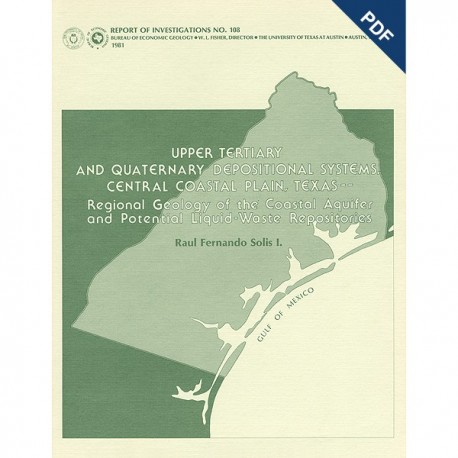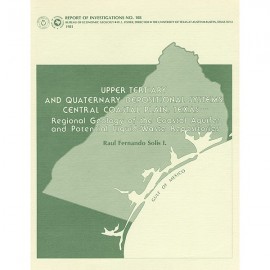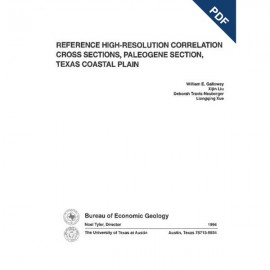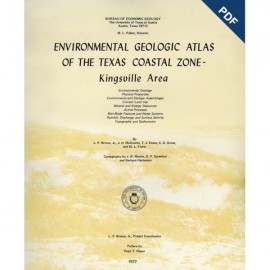Reports of Investigations
-
Books & Reports
- Reports of Investigations
- Guidebooks
- Udden Series
- Geological Circulars
- Down To Earth
- Atlases of Major Oil and Gas Reservoirs
- Texas Memorial Museum Publications
- Environmental Geologic Atlas of the Texas Coastal Zone
- Mineral Resource Circulars
- Other Reports
- Seminars and Workshops
- Handbooks
- Submerged Lands of Texas
- Symposia
- Annual Reports
- Open File Reports
-
Maps & Cross Sections
- Thematic Maps
- Miscellaneous Maps, Charts & Sections
- Geologic Atlas of Texas
- STATEMAP Project Maps
- Geologic Quadrangle Maps
- Cross Sections
- Highway Geology Map
- Energy and Mineral Resource Maps
- Shoreline Change and Other Posters
- Wilcox Group, East Texas, Geological / Hydrological Folios
- Bouguer Gravity Atlas of Texas
- River Basin Regional Studies
- Featured Maps
- Posters
- Teachers & the Public
-
Geological Society Publications
- Gulf Coast Association of Geological Societies
- Alabama Geological Society
- Austin Geological Society
- Corpus Christi Geological Society
- Houston Geological Society
- Lafayette Geological Society
- Mississippi Geological Society
- New Orleans Geological Society
- South Texas Geological Society
- GCS SEPM Publications
- Historic BEG & UT Series

Upper Tertiary and Quaternary Depositional Systems, Central Coastal Plain, Texas... Digital Download
RI0108D
A free, digital version of this publication can be found on: Texas ScholarWorks
To purchase a print version (if available): RI0108
RI0108D. Upper Tertiary and Quaternary Depositional Systems, Central Coastal Plain, Texas--Regional Geology of the Coastal Aquifer and Potential Liquid-Waste Repositories, by R. F. Solis. 89 p., 41 figs., 12 tables, 1981. doi.org/10.23867/RI109D. Downloadable PDF.
To purchase this publication in book format, please order RI0108.
ABSTRACT
Upper Miocene, Pliocene, and Pleistocene deposits in the subsurface of the central Coastal Plain of Texas were subdivided into six operational units comprising the surface-defined Fleming, Goliad, Willis, Lissie, and Beaumont Formations. These sedimentary units constitute the last major depositional episodes in the northwestern Gulf Coast Basin. Late Miocene deposition is represented by transgressive shelf and shallow-marine shales overlain by progradational clastics of the upper part of the Lower Fleming, Upper Fleming, and Lower Goliad-Willis units. Aminor Pliocene transgressive event is represented by downdip marine embayment facies of the Upper Goliad-Willis unit. Finally, Pleistocene highstand fluviodeltaic progradation (Lissie and Beaumont units) terminated pre-Holocene sedimentation.
Interpretation of sediment distribution, established by constructing a series of net- and percentage-sand maps for each unit, permits delineation of the following main depositional systems: fluvial braided-meanderbelt and floodbasin; fluvio-deltaic systems; lagoon; large marine embayments; small bayhead deltas; thick wave-dominated deltas; strandplain; and thick, stacked coastal barriers. Western fluviodeltaic systems were consistently less active than the eastern ones, which deposited greater volumes of sand.
Inherited, subtle structural influence of the deeper seated San Marcos Arch had some effect on sediment distribution and paleogradients. Shallow extensions of the deeper Vicksburg, Frio, and Miocene fault systems display respectively decreasing (from 400 ft, 122 m) displacements in the section studied. Faults clearly played a central role in the distribution of fluvial, deltaic, and strike-oriented coastal sands.
Most sands in the updip parts of the operational units contain fresh water, whereas those of downdip areas contain predominantly brackish to saline waters. The area with greatest reservoir potential for fresh water includes Victoria, Jackson, Wharton, and Colorado Counties. Possible use of sealed, thick coastal sands in the Lower Fleming unit for the disposal of industrial and municipal liquid waste is recommended.
Keywords: depositional systems, Texas Coastal Plain, aquifers. waste disposal, Tertiary, Quaternary, Fleming Formation, Goliad Formation, Willis Formation, Lissie Formation, Beaumont Formation, Texas, Colorado County, Jackson County, Victoria County, Wharton County
Citation
Solis, R. F., 1981, Upper Tertiary and Quaternary Depositional Systems, Central Coastal Plain, Texas--Regional Geology of the Coastal Aquifer and Potential Liquid-Waste Repositories: The University of Texas at Austin, Bureau of Economic Geology, Report of Investigations No. 108, 89 p.



